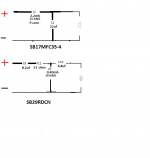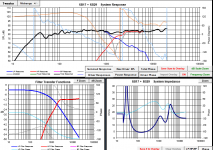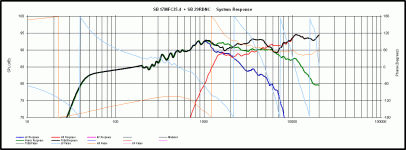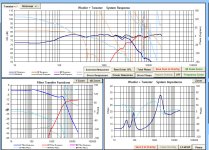Hey guys i appreciate all your input. this is my latest design its a 2nd Order Linkwitz-Riley @ 2250 hertz with a zobel network.
2nd Order Linkwitz-Riley
2nd Order Linkwitz-Riley
I think you need to read some literature on crossover design, and the basics of a loudspeaker, how it interracts with its environment and then to shoot for your own design.
A few comments:
- That looks like a classical textbook online calculator values which will most definitely produce a disappointing result
- woofer inductor is usually increased to take into account baffle step loss ( worth reading about it first ) which depends on your front baffle size and placement of the final loudspeaker.
- Zobel on tweeter is not needed, instead, depending on its impedance behaviour at Fs, you may want to dampen the peak. If it is not that pronounced, a parallel resistor or the use of an L-pad ( read about voltage divider networks ) would do the job in most cases, if it is sharp - a dedicated LCR trap is required.
- Having both 2nd order electrical on the two units AND if they are placed on a flat baffle would yield poor phase tracking. At tweeter level, which is the usual listening position for top mounted tweeter loudspeakers, a 3rd order electrical would allow easier phase integration ( still aiming for 2nd order acoustic response, read about the difference between electrical and acoustical slopes ).
- Tweeter has no resistor, which is usually added for equalisation. As you`d need to interchange it until you like its level, better put it between the amplifier and the crossover.
Best is to use a project that has been built by someone and has been reported to sound good. Lots of those are available. Lack of measurement equipment does not necessarily mean you`d end up below your expectations but it saves lots of time.
Forgot to say: Merry Christmas to all!
A few comments:
- That looks like a classical textbook online calculator values which will most definitely produce a disappointing result
- woofer inductor is usually increased to take into account baffle step loss ( worth reading about it first ) which depends on your front baffle size and placement of the final loudspeaker.
- Zobel on tweeter is not needed, instead, depending on its impedance behaviour at Fs, you may want to dampen the peak. If it is not that pronounced, a parallel resistor or the use of an L-pad ( read about voltage divider networks ) would do the job in most cases, if it is sharp - a dedicated LCR trap is required.
- Having both 2nd order electrical on the two units AND if they are placed on a flat baffle would yield poor phase tracking. At tweeter level, which is the usual listening position for top mounted tweeter loudspeakers, a 3rd order electrical would allow easier phase integration ( still aiming for 2nd order acoustic response, read about the difference between electrical and acoustical slopes ).
- Tweeter has no resistor, which is usually added for equalisation. As you`d need to interchange it until you like its level, better put it between the amplifier and the crossover.
Best is to use a project that has been built by someone and has been reported to sound good. Lots of those are available. Lack of measurement equipment does not necessarily mean you`d end up below your expectations but it saves lots of time.
Forgot to say: Merry Christmas to all!
hold up....


Had the non neo tweeter in there a second ago, luckily the neo only needed a slightly different resistor value. Box would just be typical monitor size around 9" W x 16" H baffle with drivers centered and tightly spaced.
Had the non neo tweeter in there a second ago, luckily the neo only needed a slightly different resistor value. Box would just be typical monitor size around 9" W x 16" H baffle with drivers centered and tightly spaced.
Attachments
Last edited:
Like I was saying, very easy drivers to work with. Nice job Jay.
What are the baffle dimensions and the driver positioning? Box size would probably help the OP too.
What are the baffle dimensions and the driver positioning? Box size would probably help the OP too.
Jay111 said:hold up....
- midrange rise of woofer (+5dB from reference level ?)
- 8dB per octave rolloff in lowpass, much too less: Level of "dirty upper end" of woofer far too high in the cutoff region
- tweeter electrically (due to back EMF) underdamped
- lots of ripple in the transition region of the highpass
- impedance curve may be titled "how to summon a dragon[1]"
- acoustical XO frequency to low - target was 2 ...2,3 Khz - mechanical stress and THD for tweeter unecessarily high
Still not sure whether i am finished yet ... what i see is a 6-fold misconstruction.
Who do you think shall be listening to that speaker enjoyfully guys ?
(Deaf grandma/grandpa anyone ?)
Not me, that's for shure. And not even the "average" german listener will, who's bad taste in overpronounced presence and highs has been legendary anyhow. May be you can sell that kind of "sounding" somewhere in japan (no offence meant).
Surely no chance in the US.
But keep on simulating ... and using "as few parts as possible" 😉
________________
[1] i.e. sound noteably dependent from type of amplifier
Last edited:
- midrange rise of woofer (+5dB from reference level ?)
- 8dB per octave rolloff in lowpass, much too less: Level of "dirty upper end" of woofer far too high in the cutoff region
- tweeter electrically (due to back EMF) underdamped
- lots of ripple in the transition region of the highpass
- impedance curve may be titled "how to summon a dragon[1]"
- acoustical XO frequency to low - target was 2 ...2,3 Khz - mechanical stress and THD for tweeter unecessarily high
Still not sure whether i am finished yet ... what i see is a 6-fold misconstruction.
Who do you think shall be listening to that speaker enjoyfully guys ?
(Deaf grandma/grandpa anyone ?)
Not me, that's for shure. And not even the "average" german listener will, who's bad taste in overpronounced presence and highs has been legendary anyhow. May be you can sell that kind of "sounding" somewhere in japan (no offence meant).
Surely no chance in the US.
But keep on simulating ... and using "as few parts as possible" 😉
________________
[1] i.e. sound noteably dependent from type of amplifier
I think you're confused 🙄
Bass response wasnt modeled that's manufacturers IB response. Check the woofer transfer function and spl level of woofer on the manufacturers chart to see actual BSC applied.
It's a poly cone woofer with 20 db attenuation of the "breakup". There's no ringing here, and nothing in the HD plot related
I dont stress over a couple db dip, it's a balancing act and that is one i'm willing to make.
Really you are going to criticize the impedance curve of a 4 ohm 6" woofer paired with a 95 db tweeter? Have you never look at a loudspeaker system impedance curve before?
I dont care what the OPs target crossover is, he isnt capable of designing the crossover. You obviously have no idea what the SB29 is capable of, maybe you should look into it before further implanting your foot inside your angus.
Please present us with the proper crossover for this speaker since you are such an authority on proper design. You apparently have no clue what the purpose of simulating a crossover for someone spending money on drivers with no idea what they are doing is, or why trying to simplify crossover design for a simulation makes sense. ITS NOT THE FINAL CROSSOVER. Maybe the OP will eventually get his drivers measured in box, or maybe he will be happy with what he has. Who knows, but why try to flat line a perfect response when the basis for the design is flawed.
Oh master of speaker design and golden eared authority please impart your glamorous wisdom upon us

Hey Mauds, just to give you an idea of how bad on-line xo calculators can be (if that's what you used) below is what the response looks like using the xo you posted last. Box was 9" x 15" with a 3/4" roundover on the edges. Tweeter off-centered by 3/4" at 12.25" from the bottom and woofer centered at 7".
Black is your summed response. Not a pretty sight.....
Black is your summed response. Not a pretty sight.....
Attachments
Jay1111 said:Really you are going to criticize the impedance curve of a 4 ohm 6" woofer paired with a 95 db tweeter? Have you never look at a loudspeaker system impedance curve before?
Quite often i did such "unequal" pairs in sensitivity, especially in 2-ways.
No reason for designing an impedance curve like the Rocky Mountains at all, and also no reason to have an underdamped tweeter, seeing the amplifier just through an electrical "straw" without any compensation for missing Back EMF.
But if your design skills/experience do not allow you to do any better just carry on. Do whatever you like, i am pulling myself out of this.
I left my "Statler & Waldorf" style comment,
http://img4.wikia.nocookie.net/__cb...mages/3/3d/TMS-Statler&Waldorf-BalconyBox.jpg
due to my age and character, and now i let others do the footwork.
That's how life goes ...
I mean i (luckily) don't have to listen to your end product, right ?
Last edited:
Quite often i did such "unequal" pairs in sensitivity, especially in 2-ways.
No reason for designing an impedance curve like the Rocky Mountains at all, and also no reason to have an underdamped tweeter, seeing the amplifier just through an electrical "straw" without any compensation for missing Back EMF.
But if your design skills/experience do not allow you to do any better just carry on. Do whatever you like, i am pulling myself out of this.
I left my "Statler & Waldorf" style comment,
http://img4.wikia.nocookie.net/__cb...mages/3/3d/TMS-Statler&Waldorf-BalconyBox.jpg
due to my age and character, and now i let others do the footwork.
That's how life goes ...
I mean i (luckily) don't have to listen to your end product, right ?
I'll just leave this here, the impedance curve from an extremely well respected designer's popular speaker featuring a small low sensitivity woofer and high sensitivity tweeter
You sound like the typical audiophool making a big deal over nothing. You're lucky you'll never get a chance to hear anything I design or meet me with the way you come across it wouldnt be a good day for you.
Attachments
Jay1111 said:You sound like the typical audiophool making a big deal over nothing. You're lucky you'll never get a chance to hear anything I design or meet me with the way you come across it wouldnt be a good day for you.
Thank you very much, i prefer talking "factual" about matters mentioned. You don't seem to be interested in that, so i guess we're finished here.
Loudspeakers that do not provide well tempered interfaces
- electrically
- in terms of acoustical integration with the expected listening room
do in fact generate the whole community of "audiophools" and "audio hogwash" because auditive results get more dependent from the amplifiers used, room setups etc.
But you seem the wrong partner for discussing topics like this. You think one can hear or measure whether e.g. a speaker had a "recognized designer", but that is not the case. What you can measure or hear is e.g. that electrically well tempered loudspeakers cope with a larger selection of audio gear without problems.
But this is not Your intention as it seems. So i could be asking myself - if i didn't have better things to do - who of us both being an "audiophool".
Cheers
Last edited:
Thank you very much, i prefer talking "factual" about matters mentioned. You don't seem to be interested in that, so i guess we're finished here.
Cheers
But you havent brought anything of factual relevance to the table. Your whole "call out" post was just shown to be hogwash. Nothing more then you trying to come off as an expert by pushing whatever backwards design philosophies you adhere to. You act like a modern SS amp cant handle a diverse impedance load. Maybe I missed where the OP has a SET amp?
Your world seems black and white, eh ?
Modern Solid State Amp X = Modern Solid State Amp Y
Yes, that's true up to a point: But only as long as loudspeaker designers do their homework. And that's what you should do also IMO.
Kind regards.
Modern Solid State Amp X = Modern Solid State Amp Y
Yes, that's true up to a point: But only as long as loudspeaker designers do their homework. And that's what you should do also IMO.
Kind regards.
Apparently I have more experience with real world use of diverse impedance loads on various amps then your theoretical world. And I guess you dont realize the majority of commercial speakers that are used with chitzy receivers dont exactly have great impedance curves either, try looking through stereophile or soundstage nrc measurements some time... Have a merry Christmas
Last edited:
I know that kind of arguments quite well:
"Eat sh** 10.000 flies can't be wrong."
You presented a crossover in the way "hey that's easy, the woofer has little Lvc".
Because of little Lvc and an apparently quite stiff and rather well damped cone it has also a remarkable midrange rise on axis. Your "minimalistic" approach does simply not deal whith the properties of the drivers - both of them - that's the main issue.
First of all you had to define a listening axis and tell us some thoughts how that speaker is going to be used and setup.
A 2-way having a just -8dB slope on axis with a woofer beaming and leaving pistonic motion above 2Khz is not a good idea and has never been.
Most of the points i mentioned - e.g. underdamped tweeter - you do not even care or answer.
Smooth impedance - as a design goal for being well tempered due to different amplifiers used - is one of the least important issues i mentioned.
Just because someone might have ruffled your ego and your oversimplified and maladjusted approach was not yielding that standing ovations you might have expected.
Instead you keep side tracking instead of proposing an adjusted circuit ...
"Eat sh** 10.000 flies can't be wrong."
You presented a crossover in the way "hey that's easy, the woofer has little Lvc".
Because of little Lvc and an apparently quite stiff and rather well damped cone it has also a remarkable midrange rise on axis. Your "minimalistic" approach does simply not deal whith the properties of the drivers - both of them - that's the main issue.
First of all you had to define a listening axis and tell us some thoughts how that speaker is going to be used and setup.
A 2-way having a just -8dB slope on axis with a woofer beaming and leaving pistonic motion above 2Khz is not a good idea and has never been.
Most of the points i mentioned - e.g. underdamped tweeter - you do not even care or answer.
Smooth impedance - as a design goal for being well tempered due to different amplifiers used - is one of the least important issues i mentioned.
Just because someone might have ruffled your ego and your oversimplified and maladjusted approach was not yielding that standing ovations you might have expected.
Instead you keep side tracking instead of proposing an adjusted circuit ...
Last edited:
LineArray said:Most of the points i mentioned - e.g. underdamped tweeter - you do not even care or answer.
Maybe that is because your "preferred Software" cannot even predict effects of lowering electrical damping by Back-EMF for the tweeter and you can only think about, what your software thinks for you ?
If your software can do, why don't you look at the consequences of your maladjusted highpass ?
And (point No. 7) what do you think about gradually compensating the drop in radiated energy of the tweeter in upper highs ?
Do you think your highpass is even prepared for some "decent" measures ?
Don't need it because listening on axis ?
Fine, but then see what i wrote concerning the low pass.
You are trying to sell an acoustic Frankenstein here without any concept especially due to room setup and listening position.
Your design is so far off, that there will be no chance of refinement later on, and that is the biggest problem due to design situation here, including unexperienced OP.
Kind regards.
hold up....


Had the non neo tweeter in there a second ago, luckily the neo only needed a slightly different resistor value. Box would just be typical monitor size around 9" W x 16" H baffle with drivers centered and tightly spaced.
Thanks for all the good information posted here, it was a good read. I had purchased some SB17MFC35-8 and SB29RDCN-C000-4 drivers with the plan to do a MTM-TL with an active crossover. Things have changed and an active crossover is no longer an option but I would like to do something with these speakers anyways. This will be my first "from scratch" crossover design so I am trying to get as much background info as possible. I have a calibrated measurement microphone but no bench to measure the drivers T/S parameters. I don't mind doing some tweaking later on by I want to be as close as possible the first time around.
Jay:
I really like your simple design you had posted on the last page. I am going to used it as a starting point. Did you use measured values as inputs into Jeff B's crossover software or the manufacturers measurements? Would you be able to recommend so component changes to adapt your crossover for two SB17MFC35-8 drivers?
- Status
- Not open for further replies.
- Home
- Loudspeakers
- Multi-Way
- can someone help me choose a crossover frequency



